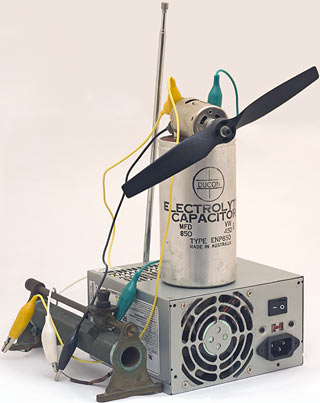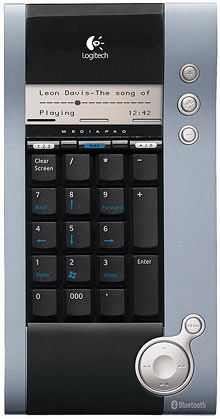
Atomic I/O letters column #99
Originally published 2009, in Atomic: Maximum Power ComputingReprinted here August 25, 2009 Last modified 16-Jan-2015.
Add enough farads and you won't need mains at all
I have a new ATX 2.3 power supply rated at 500W, that has a max recommended draw of 431W, and no power factor correction. Can I pull apart my old quality Antec 430W (rated at 430W max power) and connect pieces to the new one (capacitors and such) to improve PF and "cleanliness" of the output?
Chris

This is going to be the GREATEST PSU EVER!
Answer:
In theory, yes. In practice, no.
Patching PFC onto a power supply is less than straightforward, and not particularly desirable anyway. A PC with a power factor of 0.7 will do no real harm to anything else in your house, and home and small-office electricity consumers aren't billed by power factor.
(I ramble on about this confusing subject in this column. I've also written this piece about the plague of fake "power saving" PFC boxes on the market today.)
Adding simple parallel capacitance to the outputs of a cheap PSU is a great deal easier, and may have a real effect on system stability if you're riding the ragged edge of the cheap PSU's capabilities. The more sensible solution is, of course, to just get a better PSU, but where's the fun in that?
In practice, though, the fact that you are asking this question very probably means that you have inadequate experience to be able to hack power supplies effectively, or safely. Power-supply design is a surprisingly complex field, and there are several ways in which you can dramatically shorten your life by messing around with mains-powered equipment.
This doesn't mean you're never going to be able to dabble in this field, or even become an expert; it just means that you need to work your way up to the appropriate knowledge. Building, and understanding, electronics kits is a good start, but I also think the Sci.Electronics.Repair FAQ is an excellent jumping-off point. Read any section that grabs your interest, and whenever you hit a concept you don't understand, use that to guide further study.
Or you could try a VT100 terminal
I run a KVM (a Belkin Flip jobbie) at work to switch between the computer my place of employment provided for me and the computer I own and use for entirely appropriate things which are not, in any way, gaming/entertainment related whatsoever.
Attached to said KVM is a Bluetooth dongle, which connects to a spare Logitech diNovo MediaPad (don't ask).
This MediaPad alerts me every time a work-related email comes in, if I am using the work PC, or... tells me Artist/Track Names if I am using the "other PC not used for entertainment".
When I boot the work PC at the beginning of the day it automatically connects to the MediaPad and displays any new email, however every time I switch the KVM, I have to reconnect the MediaPad via the Bluetooth icon in the system tray.
Considering I am switching PCs often during the day this is... annoying.
Is there any way to enable the Pad to automatically connect to the appropriate computer once I switch inputs via the KVM? Or do I have to continue going through the rigmarole of "Enter your Pass Key now"?
Alex
Answer:
Fortunately for Alex's chance of getting a reply from me, this
has relevance beyond this one special application. Lots of people use Keyboard-Video-Mouse
(KVM) switches, and Bluetooth
gadgets, like headsets. Heck, there's probably someone out there trying to make a KVM
work with a Bluetooth mouse and keyboard, for some darn reason (hint: pick a mouse and
keyboard that have a Bluetooth-to-USB receiver). There's a surprising number of different
combinations of computers, monitors and input devices out there, and quick and painless
Bluetooth re-pairing could be a handy part of the puzzle.
If you can turn off encryption for the diNovo keypad's Bluetooth connection - or any other device you want to automatically connect - then you'll still have to click, but at least won't have to type. (There are also "no-passkey" Bluetooth devices, like cheap Bluetooth mice; sometimes you can connect to those without typing a passkey, sometimes you have to use a passkey of 1234 or 0000, and sometimes they won't actually connect at all.)
To make the connection truly automatic, though, you need the computers to be able to tell when you've switched from one to the other. But KVMs make every computer connected to them think that it's always got a mouse and keyboard connected (and probably also a monitor), even when the actual mouse and keyboard are connected to a different computer. (This is to avoid annoying pauses while the computers detect the "new" input and output devices every time you switch, and also to avoid "no keyboard detected" errors on reboot.) If you want something to happen every time you switch, there's no way for any computer to tell whether it's currently the one you've selected on the KVM, at least until it starts receiving keyboard and/or mouse input.
So that could be the path to a solution, if there's one to be found. You need a snippet of Visual Basic or something that tries to pair with the appropriate Bluetooth device whenever the PC starts receiving input after a pause of, say, 60 seconds, and is not paired to that device already. This won't actually help much if you can't disable encryption for the diNovo keypad thing, though; it'll just automatically bring up the box that makes you type the passkey. (Count your blessings: Some people end up with a Bluetooth keyboard that has to be re-paired every time they reboot, and requires them to type in a passkey. With their other keyboard.)
You might also be able to find a curly solution having to do with making the computer think the Bluetooth device went to sleep and then woke up again, but I don't like your chances. I shall also refrain from giving you You're Doing It Wrong suggestions involving VNC or Remote Desktop or something instead of the KVM. You might find a use for the free, cross-platform app "Synergy", though; it lets networked computers each keep their own monitor, and you choose which computer you want to use by moving your mouse pointer from one screen to the next.
It's probably possible to find a KVM that actually does have a utility, or at least an SDK, that lets you make things happen when you switch. Unfortunately, devices like that often live in Corporate Procurement Land where a pack of four AA batteries costs $25. (But comes with 24/7 phone support!)
It is PERFECTLY NORMAL to be this picky about keyboards
I was shopping for clicky keyboards from a business that would take PayPal (which unfortunately rules out Unicomp) and came across a unit from "ABS Computer Technologies", called the ABS M1.
The ridiculous crap like the gold-plated USB cable providing "lower latency" aside, it appears that the unit uses a different design for its keyswitch. I'm somewhat familiar with the buckling-spring keyswitch diagram I've seen when looking at IBM Model M 'boards, and this one appears to use a little lever of some sort as the resistance, rather than the buckling spring. I assume this is to avoid paying a royalty on the existing Model M design or some such. Have you heard of this brand/design?
Newegg lists the M1 for $US59.99, with reasonable reviews, including a reply from the manufacturer when someone's 'board wouldn't chord keys properly (whoops!).
I realize I could get more tried/true units on eBay, but I just can't bring myself to trust the sellers there, and it's a pain to post feedback, etc.
Jon

Let's see your buckling springs
do this!
Answer:
The ABS M1 is just a keyboard using Alps
keyswitches, which along with
Cherry switches
are actually the most common "clicky" technology. Only IBM and their associates made
buckling-spring keyboards, but many keyboards use Alps switches.
From the picture on the product page, the ABS M1 looks like a slightly-marked-up iOne Scorpius M1, which was also rebadged as the version 2 "Das Keyboard". I wrote about it and the current Das models here.
(I like their little diagram which proclaims the keyswitch to contain "Steam"!)
Great Mysteries of the Computer World
I'm looking at buying a Drobo, and the one thing which bugs me about it is the external power brick. They're a pain in the arse and messy and ugly and another damn thing to trip over. Why don't external drive enclosure manufacturers include an internal multi-voltage power supply and some kind of IEC lead? So much neater!
(Why yes, the Drobo will be connecting to a Mac - how did you know?)
Robert
Answer:
Now that world-compatible
switchmode power
supplies are commonplace, you'd think there wouldn't be much of an excuse for this,
wouldn't you?
I can think of a few reasons why built-in power supplies are unattractive for a lot of external storage boxes, though:
1. Power supplies make heat, and external drives often run pretty hot anyway, because they have poky little cooling fans, if any fan at all. The usual lump-in-a-wire power brick doesn't have active cooling either, of course, but just putting it in a separate case gives a lot more cooling surface area than you'd get if you built the PSU into the drive box.
2. There's no room for a power supply in really slimline drive enclosures.
3. Many external drives won't survive much of a fall - laptop drives are pretty tough, but 3.5-inch devices aren't. If, therefore, you have a reasonably stiff mains cable hooked up to the back of the box, it's more likely that the weight and inflexibility of the cable will encourage the drive to fall over, slide off the desk, et cetera.
4. World-compatible power supplies may be common, but if you don't have a given country's electricity-authority approval for the PSU you've built into your product, you will either have to pay relatively big bucks to get the PSU approved, or install a different one for each market where this problem exists. External storage is a very competitive market, so the extra expense of approving PSUs for different countries is not worth it. If your drive box just runs from (say) a 12VDC barrel plug, though, you can easily get your distributors in each country to bundle appropriate external PSUs with the product.
5. If a power supply fails, it's much easier to replace a plugpack than an internal PSU. If some ordinary consumer makes a warranty claim for a dead plugpack, you can just send them a new one, not ship the whole drive box back to you, get a tech to open the case, et cetera.
For large fancy storage boxes like the Drobo, though, some of the above problems are irrelevant and the others shouldn't be a very big deal. You really would think there'd just be an IEC socket on the back. But whaddayagonnado.


